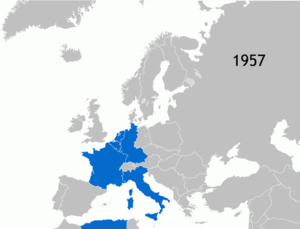Eurosclerosis
Part of a series on the |
||||||||||||||||||||||
|---|---|---|---|---|---|---|---|---|---|---|---|---|---|---|---|---|---|---|---|---|---|---|
| History of the European Union |
||||||||||||||||||||||
 | ||||||||||||||||||||||
|
||||||||||||||||||||||
|
Organisation
|
||||||||||||||||||||||
|
||||||||||||||||||||||
|
||||||||||||||||||||||
|
Topics |
||||||||||||||||||||||
| European Union portal | ||||||||||||||||||||||
Eurosclerosis (German: Eurosklerose) is a term coined in the 1970s and the early 1980s to describe both a political period and an economic pattern in Europe, alluding to the medical term sclerosis, specifically being an exact rhyme of the archaic term neurosclerosis.[1]
Economically, it was used to describe countries which had high unemployment and slow job creation in spite of overall economic growth, in contrast to what the United States experienced in the same period when economic expansion was accompanied by high job growth.
In its political context, the term "eurosclerosis" was used to describe a period with a perceived stagnation of European integration. The slow pace of enlargement, a perceived lack of democracy and economic problems meant that negative and apathetic attitudes to the European Economic Community (EEC) were high.

Wilfried Martens, Prime Minister of Belgium from 1981 to 1992, states in his 2008 memoirs that the period of "eurosclerosis" was brought to an end by the 1986 Single European Act which re-launched the drive to integration by framing the single market of the EEC.[2]
As an economic term, "eurosclerosis" has later been used more broadly to refer to overall economic stagnation.
According to one source (Paul Krugman and the Federal Reserve; see chart to the left), at least one alleged victim of Eurosclerosis (France) has gone from having a lower employment than the US in 1999, to a significantly higher employment rate following the Great Recession.[3][4]
See also
References
- ↑ World Health Organisation (1967). Manual of the International Statistical Classification of Diseases, Injuries, and Causes of Death. Geneva. http://www.who.int/iris/handle/10665/70934
- ↑ Martens, Wilfried (2008). Europe: I Struggle, I Overcome. Brussels: Springer. ISBN 978-3-540-89288-5.
- ↑ Krugman, Paul (May 21, 2014). "Cheese-eating Job Creators". New York Times. Retrieved 1 June 2014.
- ↑ Krugman, Paul (January 22, 2011). "Eurosclerosis, Then and Now". New York Times. Retrieved 1 June 2014.
- Rosser, Barkley J. and Marina V. Rosser. "Comparative Economics in a Transforming World Economy", 2nd Edition, The MIT Press, 2004. pp 240
- Henderson, David R. The Europeanization of the U.S. labor market. Public Policy. Fall, 1993.